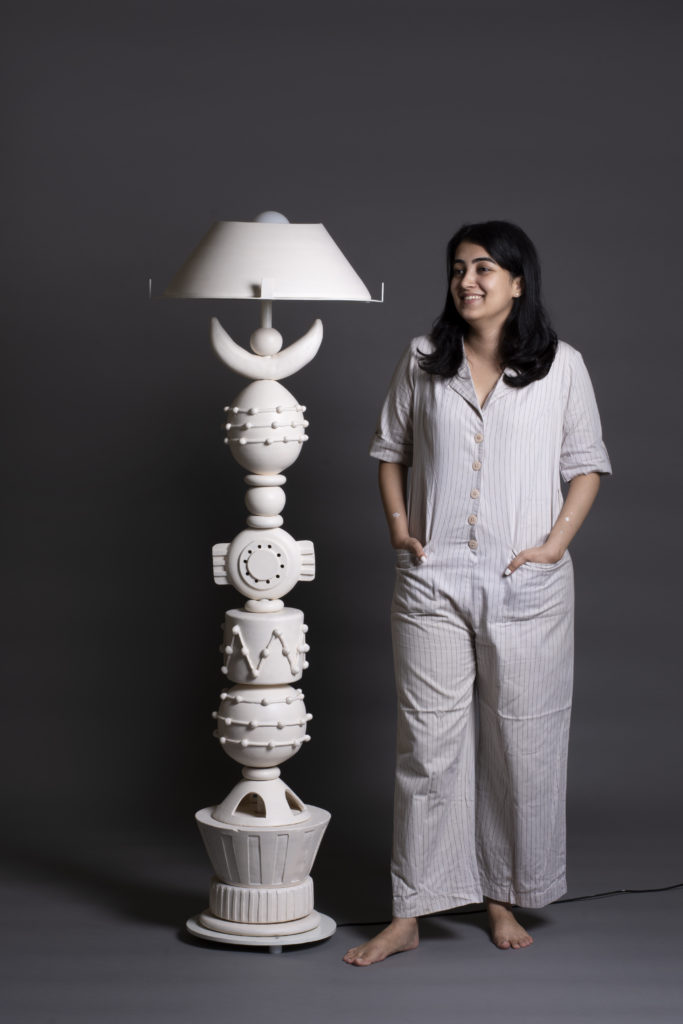



Her eponymous studio Harshita Jhamtani Designs is just a year old. But in a rather short span of time, the young architect-turned-designer has added to repertoire an extensive range of products. Her choice of materials, her explorations with forms, her commitment to sustainability, Jhamtani’s clarity of thought reflects in her designs. “As a studio, we believe that the most sustainable practice for a designer to adapt, is to create products that their patrons can buy once and cherish for a long time. We bring this very dream to life by creating long-lasting unique pieces that shall take a small step towards accelerating the low carbon economy,” says the designer.
She stormed into the decor scene with the Earth Collection – a series of handmade table lamps in clay inspired by the organic forms of nature. She credits this collection to the lockdown during which she taught herself to use a potter’s wheel. “That’s when I began to explore ceramics,” says the designer who studied architecture in Mumbai but moved on to pursue a course in furniture design from the Florence Institute of Design International.
In a tête-à-tête with Jhamtani, she talks about her fascination with the handmade, her explorations with tactile materials and her commitment towards sustainability. Here’s an excerpt.
Tell us about your first tryst with design.
Harshita Jhamtani: Studying architecture was a childhood dream for me. I remember our school essays, ‘what do you want to be when you grow up?’ while my friends wrote about being astronauts and teachers, I have always wanted to be an architect ever since I was in the 4th grade, I did spell architecture wrong a couple times for sure back then but I was just so fascinated by this profession. I planned my life around it, chose school subjects keeping the bigger goal in mind and it worked out for me.
Your choice of materials and why?
Jhamtani: I like to work with materials that can be worked on by hand. I believe every product should be unique. I am not one for mass manufacturing. So, we end up working with materials like clay and terrazzo which is stone based and not cement based. Sustainability also plays a huge role in our material selection. Our next products are going to be out of cane, recycled plastic and upcycled marble.
Your design philosophy?
Jhamtani: We create products by blending sustainable materials with minimalist designs that have strong silhouettes and are functional at their core. With utmost attention to detail, every piece is designed, crafted and manufactured in India. Our style focuses on making timeless pieces that have a soul and that push past current trends. As a studio, we believe that the most sustainable practice for a designer to adapt, is to create products that their patrons can buy once and cherish for a long time. We bring this very dream to life by creating long-lasting unique pieces that shall take a small step towards accelerating the low carbon economy.
Tell us a little about your current collection.
Jhamtani: In July 2020, I was introduced to the concept of making stoneware furniture/lights and completely fell in love with the idea and material. We started to design and develop a few products and managed to release a table design, Cactus. Little did we know, the complexities of this otherwise very flexible material. With my curiosity increasing every day, I decided to educate myself and take things in my own hands and tried making a few pieces myself. After 3 months, 4 techniques, a lot of ruined clothes, a hell lot of failed pieces and much needed help from experts in the field, we are launched the Earth Collection – A series of 5 Clay Table Lamps – Rio, Flab, Shroom, Dino & Bloom. The clay floor lamp called Asteroid is the latest addition to this collection.
Lighting, furniture, what next?
Jhamtani: We are now making terrazzo mirrors and wall murals in clay. I also really want to get into decor objects around the house like book ends, vase, tiny sculptures by the end of this year. I want us to come across as a brand that’s into ‘functional art’.
You studied architecture but moved to product design. How and why did that shift happen. Do you plan to go back to designing spaces?
Jhamtani: While studying architecture we studied all kinds of design – graphics, interior, product and even landscape but product was always my favourite class. And then I interned with Samira Rathod Design Associates who was a big part of making me a full-time product lover. She makes some of the most amazing pieces and has a separate vertical for it, Big Piano. Also, my internship at KNS architects was a little product driven and there was no turning back from there. I did a short course in Florence in Furniture design after and then worked for JSW steel as a furniture designer for almost two years before starting my vertical.
Sustainability is a very loosely used word these days. Is it just about the materials used or is it also about the process?
Jhamtani: I completely agree. A word thrown around so easily without actually understanding that its not just the end product that has to be sustainable but also the process behind it. We source all our raw materials locally, everything is manufactured in and around Mumbai and we really try to keep a check on our water and electricity consumption especially while working with clay. The one thing I really want is sustainable packaging and we are working towards it. We have a lot of places where we can constantly improve and minimize wastage.
Take us through the process of creation.
Jhamtani: Each product has a different thought behind it, sometimes its material driven, other times its inspired by a gap in the market and sometimes it just happens by accident. We usually study the material first for a good amount of time and then decide to work around the properties. For example – terrazzo is difficult to cast and finish in circular objects so when we discovered the terrazzo paste, we knew we had to do something in circle cos that isn’t so easy in the regular way. We then have sketches, renders, mockups and prototypes. Our longest product to make was the floor lamp but it was so worth all the effort.
What next?
I really want to collaborate with brands who are not into lights and furniture. It could be anything really but we want to broaden our horizons and of course collaboration is the way forward. We have had a few fun collaborations so far and that’s just kept us wanting for more.
Häcker Kitchens, a brand synonymous with quality and innovation, has a rich legacy that spans…
In this home designed by Sonal R Mutha and Aniketh Bafna, founders and principal designers…
Essentia Home’s journey in redefining luxury interiors took a bold new step as it opened…
Retail design is a balancing act. Between creating spaces that attract and those that sell,…
A few days ago, I found myself navigating an unfamiliar (for me) corner of Delhi—Vasant…
Jugal Mistri, Founder & Principal Architect, JMA Mumbai, sees mood boarding as an evolving narrative…